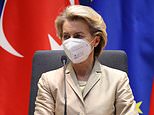If the European Union blocked all exports of coronavirus vaccines made on its turf, Britain could remain self-sufficient and still get jabs to the entire population.
However, it could come under pressure on second dose supply.
EU president Ursula von der Leyen suggested this week that the bloc could start an export ban on vaccines – the second time that threat has been made – because the continent’s rollout is going so badly.
WHICH VACCINES ARE MADE IN THE EU?
The Pfizer/BioNTech jab is currently the only vaccine used in the UK but manufactured in the EU, at the company’s plant in Puurs, Belgium.
AstraZeneca’s jab is made at home in England and Wales.
Moderna’s – which will become available in about two weeks’ time at the start of April – is produced in Switzerland, which is not an EU member and so not under von der Leyen’s jurisdiction.
The Janssen vaccine, which has not yet been approved by Britain but is likely to be next, will be made in various factories around the world, including in France, Belgium, the US and Japan. Britain’s supply is likely to come from the EU but is not expected until the second half of this year in any case.
CAN WE RELY ON ASTRAZENECA?
The good news is that the UK has ordered so many doses of the Oxford/AstraZeneca jab – 100million – that in a worst-case scenario it could immunise the entire adult population (around 50million people) using that one alone.
And supply of the Oxford/AstraZeneca jab in April and May will be around three to four times larger than of Pfizer and over 20 times as large as those from Moderna – at around three to four million available per week, according to a delivery schedule leaked by the Scottish Government in January – meaning the country will be able to rely on those for the vast majority of its vaccinations.
WHAT ABOUT PFIZER SECOND DOSES?
The bad news is that around 13million people have already had at least one dose of the Pfizer/BioNTech vaccine, and the majority of them are still waiting for a second jab, which are likely only to come from within the EU.
This means that Britain has to have another 13million doses at least, in order to make sure those people are fully protected.
And it also hopes for another 14million so it can immunise the total 20million for whom doses were ordered.
Pfizer and the UK Government have both refused to comment on the supply chain but deliveries are expected to be smaller in April.
The Department of Health may have to stop using Pfizer supplies for first-time vaccinations within weeks if the spectre of export issues remains, MailOnline understands, because it must begin to stockpile supplies to cope with the huge demand for second doses that will come in April, three months after the rollout exploded in January.
The delivery projections accidentally published by the Scottish Government suggest its supplies of Pfizer will tumble from 130,000 per week throughout March to just 78,000 per week in April and May.
This could equate to approximately 1.5million per week for the whole UK dropping to 950,000 per week, according to the distribution formula used by the Government.
The UK vaccinated more than 2.5million people per week throughout most of January and February and around half of all doses used were Pfizer, meaning the demand for second doses could exceed one million per week in April and May.
If this is the case the Government will have to use all of the projected 950,000 per week suggested in the Scottish delivery schedule while also hoping it has enough left over to meet this rolling demand – leaving little to no capacity for people to receive the Pfizer jab for the first time.
Pfizer declined to comment on its supply chain but said: ‘In the UK, we are continuing to liaise closely with the Government to deliver the 40million doses of the Pfizer/BioNTech vaccine that we have committed to supply before the end of the year and can confirm that overall projected supply remains the same for quarter one (January to March).’
